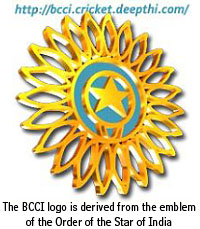

Board of Control for Cricket in India (BCCI)
Full ICC Member since 31 May 1926Latest BCCI News
BCCI is the apex governing body for cricket in India and lays down its law. Follow the links to find comprehensive news and information in BCCI.Board of Control for Cricket in India
| BCCI: Index • Latest News • BCCI related Cricket Polls • Presidents • Secretaries • Contact Info • Indian Cricket History |
Board of Control for Cricket in India
BCCI, India
 The Board of Control for Cricket in India, or BCCI, is the governing body for cricket in India. This is India's richest sporting body. The President of BCCI is Sharad Pawar (elected 29 November, 2005). Niranjan Shah is the secretary.
The Board of Control for Cricket in India, or BCCI, is the governing body for cricket in India. This is India's richest sporting body. The President of BCCI is Sharad Pawar (elected 29 November, 2005). Niranjan Shah is the secretary.
All the office-bearers for the year 2004-05, were elected at the annual general meeting of the Board held in Kolkata.
On January 10, 2005, the Supreme Court of India ordered the removal of Jagmohan Dalmiya from the post of patron-in-chief of BCCI and also asked the board to complete its annual general meeting (AGM) which had been adjourned on September 30, 2004.
The legality of the office-bearer's election at the board's annual general meeting (AGM) held on September 29, 2004 is subjudice.
BCCI Cricket News November 2006
Win and flourish or flop and lose money
Nov 25, 2006
The performance-related match fee structure for Indian players that is being mooted by the Cricket Board would be based on overall performance of the team and not on individual displays, a BCCI official said on Saturday.
"The proposal is to take into consideration the performance of the team as a whole and not individuals for players' match fees," Board's Chief Administrative Officer Ratnakar Shetty said. "For example if the match fee is Rs 100, Rs 60 may be directly given to the players and the rest kept back. If the team wins, the players would get a bonus too along with the amount retained. "But in case of a failure, the amount kept in abeyance would not be paid," Shetty explained.
Asked what would happen in case of a draw in a Test match, Shetty said so far the modalities for it had not yet been finalised. The Indian players are yet to sign the new contracts with the Board and clauses relating to the proposed performance based match fees could be incorporated in the fresh contracts before the players sign on the dotted line on their return from South Africa.
BCCI set new role for selectors
Nov 22, 2006
India's premier domestic event, the Ranji Trophy starting in different parts of the country on Thursday, the BCCI has thought of steps to raise the profile and importance of the event.
To begin with, the board has asked the five-men national selection committee not to travel with the Indian team when the domestic season is in full swing. Besides, during this period, BCCI will also not send any India A or under-19 teams on tours. "We have decided that the selectors will hunt for new talent in the domestic circuit. We have also decided to scrap India A and Under-19 tours when the domestic players are representing their individual states," BCCI secretary Niranjan Shah told TOI on Wednesday. The board had introduced the practice of selectors taking turns in accompanying the team on tours earlier this year itself. "The selectors have already seen those playing for the country and there is no point in travelling with the team. But if they are regularly watching the domestic players, they can take note of emerging stars. And since we need good players to make domestic cricket a success, we have scrapped the India A and Under-19 tours during the season," Shah added. Chairman of the senior selection committee, Dilip Vengsarkar echoed the thoughts. "Through this exercise, we can get to see some good performances. Of course, we cannot attend all the matches but we can move around and see a couple of them and work on the bench strength." Vengsarkar also said, "We also need sporting wickets to lift the standard of cricket here." On the monetary front, domestic cricketers are not going to get any pay hike this year. According to Shah, due to less number international matches at home, BCCI's income from TV rights will be less than last year which will affect the cricketers' share adversely. Shah also informed that first class cricketers will get their arrears for the 2005-06 season in December.
- Board of Control for Cricket in India - October 2006 News
- Board of Control for Cricket in India - September 2006 News
- Board of Control for Cricket in India - August 2006 News
- Board of Control for Cricket in India - July 2006 News
- Board of Control for Cricket in India - June 2006 News
- Board of Control for Cricket in India - May 2006 News
- Board of Control for Cricket in India - April 2006 News
- Board of Control for Cricket in India - March 2006 News
- Board of Control for Cricket in India - February 2006 News
- Board of Control for Cricket in India - January 2006 News
- Board of Control for Cricket in India - December 2005 News
- Board of Control for Cricket in India - November 2005 News
Cricket in India
Cricket is the unofficial national sport of India, and its development has been closely tied up with the history of the country, mirroring many of the political and cultural developments around issues such as race, caste, religion and nationality. Though cricket is indubitably the most popular sport in India, it is not the nation's national sport (a distinction held by field hockey).Cricket, like field hockey, was first introduced to India by the British. The earliest recorded match was played in 17211 by British sailors on shore leave. With the expansion of British rule throughout the subcontinent, the British took the game with them wherever they went. However, the early history of the game was focused largely on the large cities, particularly Bombay (now Mumbai).
The first Indians to play the game at a high level were the Parsi minority in Bombay. Beginning in 1892, an annual match was played between the Parsis and the Europeans. In 1907, this became a triangular tournament with the Hindus fielding a team, and in 1912 a Muslim team entered what was for twenty years the biggest tournament in Indiathe Bombay Quadrangular.
Among the biggest stars in the early years of Indian cricket were the four Palwankar brothers, Shivram, Ganpat and Vithal but particularly the slow left-arm bowler, Palwankar Baloo. This was particularly noteworthy as the Palwankars were from one of the untouchable castes. Treated as equals on the cricket field, off-field they often faced discrimination. This changed slowly; however, Palwankar Vithal did eventually captain the Hindu team in the quadrangular.
The formation of the Board of Control for Cricket in India in 1929 led to a first Test match with England three years later. In 1935, the Ranji Trophy began; it continues to the present as the leading regional tournament in India, with each state fielding a team. The trophy was a deliberate attempt to avoid the communalism of the quadrangular tournament.
The Indian cricket team has won one Cricket World Cup, in 1983. India also reached the finals in 2003, but lost to Australia. In recent years, Indian cricket has been marked by the intense and occasionally violent rivalry with Pakistan. Furthermore, there were several scandals related to match fixing and gambling, but these were not restricted to India; they plagued several different teams.
International cricket in India generally does not follow a fixed pattern like, for example, the English schedule under which the nation tours other countries during winter and plays at home during the summer. Generally, there has recently been a tendency to play more one-day matches than Test matches.
Ranji Trophy
Founded as 'The Cricket Championship of India' at a meeting of the Board of Control for Cricket in India in July 1934. The first Ranji Trophy fixtures took place in the 1934-35 season. Syed Mohammed Hadi of Hyderabad was the first batsman to score a century in the tournament. The Trophy was donated by H.H. Sir Bhupendra Singh Mahinder Baha-dur, Maharajah of Patiala in memory of His late Highness Sir Ranjitsinhji Vibhaji of Nawanagar. In the main, the Ranji Trophy is composed of teams representing the states that make up India. As the political states have multiplied, so have cricket teams, but not every state has a team. Some states have more than one cricket team, e.g. Maharashtra and Gujarat. There are also 'odd' teams like Railways, and Services representing the armed forces. The various teams used to be grouped into zones - North, West, East, Central and South - and the initial matches are played on a league basis within the zones. The top two (till 1991-92), top three teams from each zone then play in a national knock-out competition. Starting with the 2002-03 season, the zonal system has been abandoned and a two-division structure has been adopted with two teams being promoted from the plate league and two relegated from the elite league. If the knockout matches are not finished they are decided on the first-innings lead.Irani Trophy
The Irani Trophy tournament was conceived during the 1959-60 season to mark the completion of 25 years of the Ranji Trophy championship and was named after the late Z.R. Irani, who was associated with the Board of Control for Cricket in India (BCCI) from its inception in 1928, till his death in 1970. The first match, played between the Ranji Trophy champions and the Rest of India was played in 1959-60 with the trophy being instituted in the name of Zal Irani, long time treasurer of the Board of Control for Cricket in India and a keen patron of the game. For the first few years, it was played at the fag end of the season. Realising the importance of the fixture, the BCCI moved it to the beginning of the season. Since 1965-66, it has traditionally heralded the start of the new domestic season. The Irani Trophy game ranks very high in popularity and importance. It is one of the few domestic matches that is followed with keen interest by cricket lovers in the country. Leading players take part in the game which has often been a sort of selection trial to pick the Indian team for foreign tours.Duleep Trophy
The Duleep Trophy competition was started by the Board of Control for Cricket in India in 1961-62 with the aim of providing a greater competitive edge in domestic cricket - because, apart from the knock-out stages of the Ranji Trophy, that competition proved predictable, with Bombay winning for fifteen consecutive years. The Duleep was also meant to help the selectors in assessing form. The original format was that five teams, drawn from the five zones, play each other on a knock-out basis. From the 1993-94 season, the competition has been converted to a league format.Harbhajan Singh Memorabilia
Singh's Magnificent Hat Trick
Own a piece of Indian Cricket History
 On the 1st Day of the 2nd Test, India versus Australia, in March 2001, at Eden Gardens in Kolkata, Harbhajan Singh achieved what no other Indian cricketer had ever done - he snared a magnificent Hat Trick.
On the 1st Day of the 2nd Test, India versus Australia, in March 2001, at Eden Gardens in Kolkata, Harbhajan Singh achieved what no other Indian cricketer had ever done - he snared a magnificent Hat Trick.
Limited Edition Magnificent photographic collage of the three dismissals with the hat trick at Calcutta capturing photograph in each piece being personally signed by Harbhajan Singh. Each piece .encased in a timber frame with Perspex glazing and is supported by A-Tag microchip authentication technology, and comes complete with a Certificate of Authenticity.
 Buy now / Read more / Other cricket memorabilia
Buy now / Read more / Other cricket memorabilia



